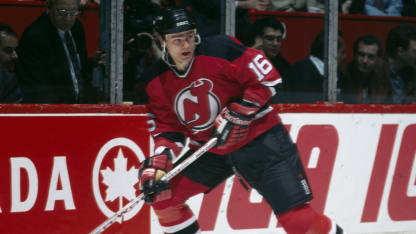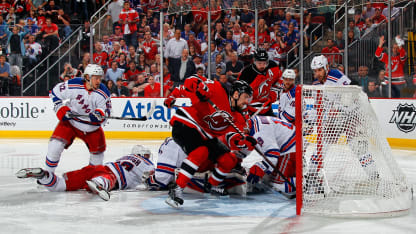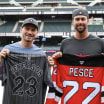1. Bobby Holik
The best fourth line center on the best fourth line in NHL history, Bobby featured a two-way, 200-foot game that could qualify him for first line on at least half the NHL teams. He was pivotal in helping pace New Jersey to Stanley Cup wins in 1995 and 2000. He boasted the Three S's – savvy, solid and sincere. Sure, Bobby could be in the Golden Circle but Jacques Lemaire preferred him between Mike Peluso and Randy McKay. The "Crash Line" became arguably the best of its genre in history; powered by Holik for two out of the three Cup years. He credits Jacques Lemaire for his success. "Best coach I ever had," Holik told me, "by far."
2. Sergei Brylin
The peach-faced kid arrived in Albany in September 1994 for his first Devils training camp. Although he appeared too small and too fragile to make the varsity, he eventually made the big team and was solid no matter where he was placed. A three-time Cup-winner, Sergei scored one of the Devils most important goals in Game 4 of the 1995 Cup-clincher. He was quiet with the media, but ever-effective in the clutch. Credit to the organization for recognizing Brylin's unique qualities by honoring him earlier in the season with only the second "Ring of Honor " to be bestowed on a Devil; Dr. John McMullen being the first winner. Despite that accolade, Sergei always has preferred the role of Mr. Unobtrusive.
3. Chris Terreri
Before Marty Brodeur arrived, tiny "T-Bone" was a veritable octopus in the net. He saved the club by three-times pinch-goaling for Brodeur during the 1994 Conference Final at hostile Boston Garden and winning them all. Sure, it was out of mind pressure yet the Rhode Islander handled it with his customary aplomb. Marty's shadow was never-ever fazed. Teammates always maintained that T-Bone had ice water in his veins. Still, as good as he was, Chris never could emerge from the Brodeur shadow. In fact, nobody could.
4. Glenn Resch
When Dr. John McMullen bought the Colorado Rockies and moved the sextet to East Rutherford, the customers needed - and wanted - a role model to love. One of a kind then and one of a kind now, “Chico” dazzled on the ice and should go down in history as "The Friendliest Player Of All-Time." But because the talent around him was mediocre at the time, the excellence of Resch was not recognized as it should have been. Typically, Glenn shook it off; he was having too much fun being the loveable Chico.
5. John Madden
Arguably the best two-way defensive forward in contemporary hockey, “Mad Dog” worked with Jay Pandolfo like two perfectly meshed gears. I gave Mad Dog the edge simply because I liked him better on a breakaway than Pando. Many critics have argued that they must be considered as a single entity because they so often were coupled on the ice. It's worth noting that Lamoriello discovered Madden at the University of Michigan although scouts had urged him to pick another prospect. Quiet in the dressing room, Mad Dog could be eloquent when pinned down by a reporter but he preferred playing it low-key.
6. Jay Pandolfo
This dedicated New Englander is only differentiated from Madden by Johnny's
Toronto accent. The fact is that Pando and Mad Dog were a defensive-offense menace - and also at the top of their games at penalty-killing. Really, this was a rare pair made in hockey heaven. If one were to seek a difference it would be Jay's calmer demeanor but that only served to blanket his high-octane intensity.
7. Jamie Langenbrunner
Some believe that the Minnesotan is the most unappreciated player and captain in team history. A quiet leader, Jamie was wing man on the team's best line in the mid-to-late 2000s. Zach Parise was on the other wing with Travis Zajac at center. Jamie scored 11 goals and 18 points overall in the Devils last Cup-winning season of 2003. Over time in New Jersey, Jamie also was a mentor to the younger Parise. Zach could confirm that he learned leadership techniques from Jamie.
8. Doug Brown
The 1988 playoff run was one of the highest points of franchise life and this feisty forward out of Boston College was one of the most dependable defensive forwards as a penalty-killer. During the arresting 1988 postseason sprint, Doug scored five goals, including an overtime winner in Game 2 of the Wales Conference Final at Boston. He had an All-American, Boy Scout quality about him that endeared him to original fans. To increase his skating speed, Doug took lessons from pioneer power skating instructor Laura Stamm. And in this case, it worked to perfection.
9. Claude Loiselle
A Gallic version of Doug Brown, Claude combined smarts, a snarl and a two-way checking style that threw endless foes off their games. Being buried behind the stars never bothered Loiselle because he simply came to play every night and that made him an essential
cog on the earlier up and coming teams. Media types adored him because he was so interested in their side of the business. During injury sabbaticals he could be found in the TV truck learning how games were being produced for the big screen. (p.s. No surprise, Claude was a terrific interview!)























